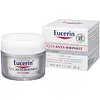What's inside
What's inside
 Key Ingredients
Key Ingredients

 Benefits
Benefits

 Concerns
Concerns

 Ingredients Side-by-side
Ingredients Side-by-side

Water
Skin ConditioningGlycerin
HumectantEthylhexyl Cocoate
EmollientHydrogenated Coco-Glycerides
EmollientStearyl Alcohol
EmollientButylene Glycol
HumectantCetyl Alcohol
EmollientCaprylic/Capric Triglyceride
MaskingButyrospermum Parkii Butter
Skin ConditioningGlyceryl Stearate Citrate
EmollientOctyldodecanol
EmollientTocopheryl Acetate
AntioxidantUbiquinone
AntioxidantBiotin
AntiseborrhoeicBiosaccharide Gum-1
HumectantSodium Ascorbyl Phosphate
AntioxidantZea Mays Oil
EmulsifyingBeta-Carotene
Skin Conditioning1,2-Hexanediol
Skin ConditioningCarbomer
Emulsion StabilisingSodium Hydroxide
BufferingTrisodium EDTA
Dehydroacetic Acid
PreservativePhenoxyethanol
PreservativeWater, Glycerin, Ethylhexyl Cocoate, Hydrogenated Coco-Glycerides, Stearyl Alcohol, Butylene Glycol, Cetyl Alcohol, Caprylic/Capric Triglyceride, Butyrospermum Parkii Butter, Glyceryl Stearate Citrate, Octyldodecanol, Tocopheryl Acetate, Ubiquinone, Biotin, Biosaccharide Gum-1, Sodium Ascorbyl Phosphate, Zea Mays Oil, Beta-Carotene, 1,2-Hexanediol, Carbomer, Sodium Hydroxide, Trisodium EDTA, Dehydroacetic Acid, Phenoxyethanol
Water
Skin ConditioningGlycerin
HumectantIsopropyl Myristate
EmollientPropanediol
SolventCaprylic/Capric Triglyceride
MaskingCetearyl Olivate
Butylene Glycol Dicaprylate/Dicaprate
EmollientC12-15 Alkyl Benzoate
AntimicrobialCetearyl Alcohol
EmollientSorbitan Olivate
EmulsifyingSodium Polyacrylate
AbsorbentPhenoxyethanol
PreservativeDimethicone
EmollientEthylhexylglycerin
Skin ConditioningDisodium EDTA
1,2-Hexanediol
Skin ConditioningCitrus Aurantium Bergamia Fruit Oil
MaskingOlea Europaea Fruit Oil
MaskingBrassica Oleracea Acephala Leaf Extract
HumectantCitrus Aurantium Dulcis Fruit Extract
MaskingCitrus Grandis Peel Oil
MaskingLavandula Angustifolia Oil
MaskingCedrus Atlantica Bark Oil
MaskingPelargonium Graveolens Flower Oil
MaskingJasminum Officinale Oil
MaskingTocopherol
AntioxidantMyrtus Communis Oil
MaskingRose Flower Oil
MaskingVanilla Planifolia Fruit Extract
Skin ConditioningThuja Occidentalis Leaf Extract
AntioxidantFerula Galbaniflua Resin Oil
AntimicrobialLinalool
PerfumingLimonene
PerfumingWater, Glycerin, Isopropyl Myristate, Propanediol, Caprylic/Capric Triglyceride, Cetearyl Olivate, Butylene Glycol Dicaprylate/Dicaprate, C12-15 Alkyl Benzoate, Cetearyl Alcohol, Sorbitan Olivate, Sodium Polyacrylate, Phenoxyethanol, Dimethicone, Ethylhexylglycerin, Disodium EDTA, 1,2-Hexanediol, Citrus Aurantium Bergamia Fruit Oil, Olea Europaea Fruit Oil, Brassica Oleracea Acephala Leaf Extract, Citrus Aurantium Dulcis Fruit Extract, Citrus Grandis Peel Oil, Lavandula Angustifolia Oil, Cedrus Atlantica Bark Oil, Pelargonium Graveolens Flower Oil, Jasminum Officinale Oil, Tocopherol, Myrtus Communis Oil, Rose Flower Oil, Vanilla Planifolia Fruit Extract, Thuja Occidentalis Leaf Extract, Ferula Galbaniflua Resin Oil, Linalool, Limonene
Ingredients Explained
These ingredients are found in both products.
Ingredients higher up in an ingredient list are typically present in a larger amount.
1,2-Hexanediol is a synthetic liquid and another multi-functional powerhouse.
It is a:
- Humectant, drawing moisture into the skin
- Emollient, helping to soften skin
- Solvent, dispersing and stabilizing formulas
- Preservative booster, enhancing the antimicrobial activity of other preservatives
This ingredient is an emollient, solvent, and texture enhancer. It is considered a skin-softener by helping the skin prevent moisture loss.
It helps thicken a product's formula and makes it easier to spread by dissolving clumping compounds.
Caprylic Triglyceride is made by combining glycerin with coconut oil, forming a clear liquid.
While there is an assumption Caprylic Triglyceride can clog pores due to it being derived from coconut oil, there is no research supporting this.
Learn more about Caprylic/Capric TriglycerideGlycerin is already naturally found in your skin. It helps moisturize and protect your skin.
A study from 2016 found glycerin to be more effective as a humectant than AHAs and hyaluronic acid.
As a humectant, it helps the skin stay hydrated by pulling moisture to your skin. The low molecular weight of glycerin allows it to pull moisture into the deeper layers of your skin.
Hydrated skin improves your skin barrier; Your skin barrier helps protect against irritants and bacteria.
Glycerin has also been found to have antimicrobial and antiviral properties. Due to these properties, glycerin is often used in wound and burn treatments.
In cosmetics, glycerin is usually derived from plants such as soybean or palm. However, it can also be sourced from animals, such as tallow or animal fat.
This ingredient is organic, colorless, odorless, and non-toxic.
Glycerin is the name for this ingredient in American English. British English uses Glycerol/Glycerine.
Learn more about GlycerinPhenoxyethanol is a preservative that has germicide, antimicrobial, and aromatic properties. Studies show that phenoxyethanol can prevent microbial growth. By itself, it has a scent that is similar to that of a rose.
It's often used in formulations along with Caprylyl Glycol to preserve the shelf life of products.
Water. It's the most common cosmetic ingredient of all. You'll usually see it at the top of ingredient lists, meaning that it makes up the largest part of the product.
So why is it so popular? Water most often acts as a solvent - this means that it helps dissolve other ingredients into the formulation.
You'll also recognize water as that liquid we all need to stay alive. If you see this, drink a glass of water. Stay hydrated!
Learn more about Water